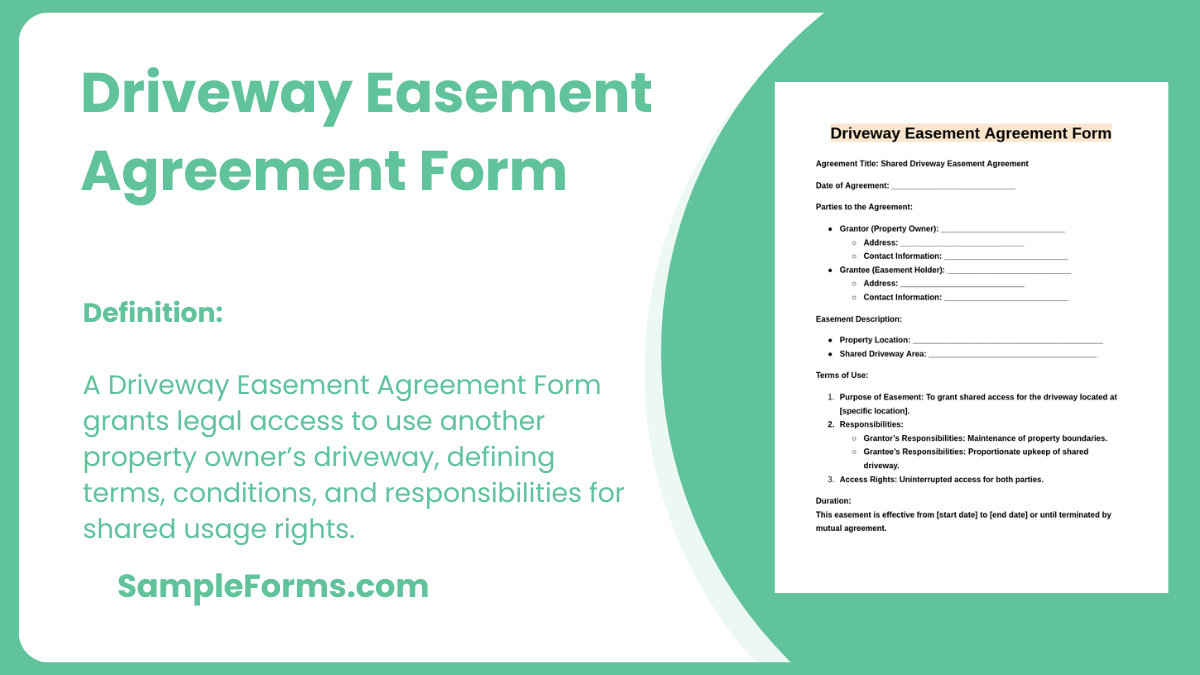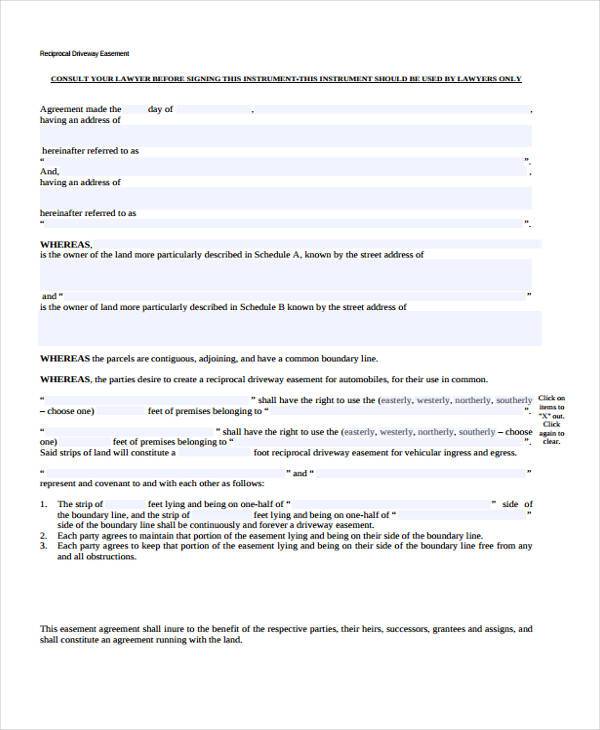A Driveway Easement Agreement Form is essential for outlining shared access rights between property owners. It sets clear boundaries, terms, and responsibilities, ensuring mutual understanding and preventing future disputes. Whether for residential or commercial properties, this Agreement Form provides a legally binding framework for smooth coexistence and access management. Similar to a Commercial Agreement Form, this document ensures compliance with local regulations and protects the interests of all involved parties. Explore this comprehensive guide for practical tips, examples, and best practices to create or customize an easement agreement tailored to your specific needs.
Download Driveway Easement Agreement Form Bundle
What is Driveway Easement Agreement Form?
A Driveway Easement Agreement Form is a legal document granting one party the right to use another party’s driveway for access. This agreement outlines terms, conditions, and maintenance responsibilities, ensuring clear understanding and preventing disputes. Commonly used in real estate, it is designed to protect property rights while fostering cooperation. Like any well-structured agreement, it requires consent, signatures, and compliance with local laws to be enforceable. This form is vital for maintaining property harmony and ensuring legal access arrangements.
Driveway Easement Agreement Format
Parties to the Agreement:
- Grantor: [Name of Property Owner]
- Grantee: [Name of Easement Holder]
Property Details:
- Address of Property: _____________________________
- Description of Easement Area: _____________________
Easement Terms:
- Purpose of Easement: ____________________________
- Duration of Easement: ___________________________
- Maintenance Responsibilities: _____________________
Restrictions:
- Prohibited Uses: _________________________________
- Environmental Impact Considerations: _______________
Agreement Conditions:
- Payment (if applicable): ___________________________
- Indemnity Clause: _______________________________
Signatures:
- Grantor: ____________________________
- Grantee: ____________________________
- Date of Agreement: __________________
Shared Driveway Easement Agreement Form

A Shared Driveway Easement Agreement Form establishes clear terms for shared driveway access between parties, ensuring legal and maintenance responsibilities. Similar to a Commercial Rental Agreement Form, it secures mutual rights and obligations for shared property use.
Driveway Easement Agreement Form Between Neighbors

A Driveway Easement Agreement Form Between Neighbors outlines access and maintenance rights for adjoining properties. Like a Settlement Agreement Form, it promotes harmonious coexistence and resolves potential disputes through legally binding terms.
Real estate Driveway Easement Agreement Form

A Real Estate Driveway Easement Agreement Form is critical for property transactions requiring driveway access. Much like a Rental Lease Agreement Form, it defines specific terms to protect both property owners and users.
Driveway Easement Agreement Form California

A Driveway Easement Agreement Form California adheres to state-specific laws for shared driveway use. Like a Trailer Rental Agreement Form, it ensures legal clarity and accountability, meeting all required regional compliance standards.
Browse More Driveway Easement Agreement Forms
Reciprocal Driveway Easement Agreement Form
Joint Driveway Easement Deed Form
Road Easement Agreement Form in PDF
Example of Driveway Easement Agreement Form
Basic Driveway Easement Agreement Form
Simple Driveway Easement Agreement Form
Utility Driveway Easement Agreement
Printable Easement Agreement Form
How Do You Remove an Easement from Your Property in Washington State?
Easement removal requires mutual agreement, legal action, or proof of nonuse, like modifying a Room Agreement Form for specific conditions.
- Mutual Consent: Both parties agree to terminate the easement.
- Abandonment: Prove that the easement has not been used for an extended period.
- Court Action: Obtain a legal order to remove the easement.
- Merger of Ownership: When the same person owns both properties involved.
- Change of Purpose: Easement is no longer necessary for its original purpose.
How Are Most Valid Easements Created?
Most easements are created through written agreements, court orders, or longstanding use, akin to drafting an Electrical Subcontractor Agreement Form for legal clarity.
- Express Agreement: Parties agree to terms in writing.
- Prescriptive Easement: Established through continuous, open, and adverse use.
- Implied Easement: Arises when a property is divided and access is necessary.
- Necessity Easement: Granted for essential access to landlocked properties.
- Court Order: Legal enforcement of an easement due to disputes.
How Do Easements Work in North Carolina?
In North Carolina, easements grant access or usage rights while maintaining ownership. Similar to a Non Compete Agreement Form, they protect specific rights and obligations.
- Grantor and Grantee: Defined roles for property owner and easement holder.
- Usage Rights: Limited to the agreed-upon purpose.
- Transferability: Easements often transfer with property ownership.
- Legal Recording: Easements should be recorded in public records.
- Dispute Resolution: Managed through mediation or legal action.
What Is the Disadvantage of an Easement?
Easements can limit property usage, cause disputes, and reduce property value. They require careful management, similar to a Business Purchase Agreement Form, ensuring clarity in agreements.
- Restricted Property Use: Property owners may face limitations on how they use their land.
- Potential Conflicts: Disputes may arise between easement holders and property owners.
- Reduced Value: Easements can negatively impact property resale value.
- Maintenance Responsibilities: Shared maintenance can lead to disagreements over costs.
- Permanent Rights: Easements are often irrevocable and transfer with property ownership.
In What Way Is an Easement Protected by a Property Fence?
Fences can mark boundaries and prevent misuse of easement areas, much like a Parking Agreement Form delineates specific usage rights.
- Defines Boundaries: Clearly separates easement from private property.
- Prevents Encroachment: Stops unauthorized usage by third parties.
- Improves Security: Protects easement areas from damage or trespass.
- Visual Clarification: Clearly indicates shared or restricted access zones.
- Legal Compliance: Ensures physical demarcation aligns with the easement terms.
Whose owner receives the benefit of an easement is called what?
The owner who benefits from an easement is the dominant estate holder, akin to a House Agreement Form detailing property rights and benefits.
Can a property owner block an easement in Minnesota?
No, easements are legally binding, and blocking access can result in legal consequences, similar to violating a Commercial Agreement Form.
What is an easement in simple terms?
An easement is a legal right allowing someone to use another’s property for specific purposes, much like an Assignment Agreement Form transfers rights.
What is a necessary easement?
A necessary easement grants access to landlocked properties, ensuring essential use, comparable to a Holding Deposit Agreement Form ensuring access under specific terms.
Can a property owner block an easement in NC?
No, blocking an easement in North Carolina violates legal terms, as seen with enforceable terms in a Roommate Agreement Form.
How does an easement affect a mortgage?
An easement can lower property value or restrict its use, influencing mortgage approvals, much like conditions in an Loan Agreement Form.
How wide are power line easements?
Power line easements are typically 20–100 feet wide, depending on utility needs, similar to the flexibility outlined in a Installment Agreement Form.
What is the most common type of easement?
Access easements, like driveway or utility easements, are the most common, ensuring shared usage rights, akin to a Financial Agreement Form managing shared responsibilities.
What does ingress and egress mean in an easement?
Ingress means entering, and egress means exiting a property through an easement, ensuring access, much like an Investment Agreement Form secures financial entry and exit.
Can a property owner block an easement in South Carolina?
No, property owners cannot block easements in South Carolina as they are legally binding, similar to a Joint Venture Agreement Form ensuring mutual access.
A Driveway Easement Agreement Form ensures transparent access rights and smooth property relations, similar to a Contingency Fee Agreement Form outlining legal service terms. By defining clear conditions, roles, and maintenance duties, it prevents conflicts and promotes harmony. This form is versatile and adaptable, catering to various property scenarios, whether residential, commercial, or mixed-use. Proper execution ensures legal enforceability, protecting the rights of all parties involved. Use this agreement as a practical tool to establish long-lasting and fair access arrangements while safeguarding property value and relationships.
Related Posts
-
FREE 50+ Mortgage Forms Download – How to Create Guide, Tips
-
FREE 4+ Real Estate Listing Information Forms in PDF | MS Word
-
FREE 7+ Garage (Parking) Rental Agreement Forms in PDF | MS Word
-
FREE 7+ Office Lease Agreement Forms in PDF | MS Word
-
FREE 4+ Salon Booth Rental Agreement Forms in PDF | MS Word
-
FREE 5+ Roommate Rental Agreement Forms in PDF | MS Word
-
Electrical Subcontractor Agreement Form
-
FREE 10+Non-Disclosure Forms in PDF | MS Word
-
FREE 5+ Construction Subcontractor Agreement Forms in PDF | MS Word
-
FREE 5+ Real Estate Lease Guarantee Co-Signer Agreement Forms in PDF | MS Word
-
FREE 5+ Lease with an Option to Purchase Agreement Forms in PDF | MS Word
-
FREE 7+ Realtors Lease Agreement Forms in PDF
-
FREE 10+ Subordination Agreement Forms in PDF | MS Word
-
FREE 10+ Condominium Lease Agreement Forms in PDF | MS Word
-
FREE 5+ Lottery Agreement Forms in PDF | MS Word











